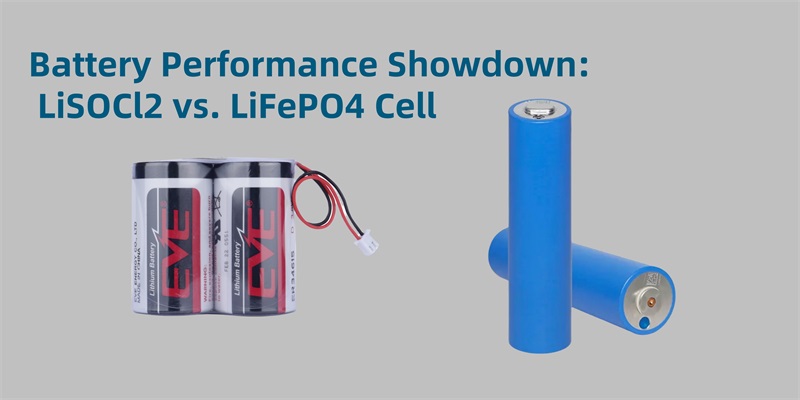Battery Performance Showdown: LiSOCl2 vs. LiFePO4 Cell
When it comes to selecting the right battery technology for your needs, understanding the distinct advantages of each type is crucial. Lithium Thionyl Chloride (LiSOCl2) and LiFePO4 battery cell are two of the most commonly used lithium batteries, each offering unique characteristics that cater to different applications. This article compares the two battery types to help you make an informed decision based on your specific energy needs.

What Are LiSOCl2 and LiFePO4 Batteries?
LiSOCl2 Batteries:
LiSOCl2 batteries use lithium metal and thionyl chloride as their chemical system. Known for their high energy density and long-lasting discharge, these batteries are designed to provide stable, low-power energy over extended periods. They are ideal for remote sensing devices, smart meters, medical equipment, and any application where battery replacement or recharging is infrequent.
LiFePO4 Batteries:
On the other hand, LiFePO4 batteries use lithium iron phosphate (LiFePO4) as the cathode material. These batteries stand out due to their superior safety features, long lifespan, and ability to handle high-power demands. Commonly found in electric vehicles (EVs), energy storage systems, and home appliances, LiFePO4 batteries are favored for applications requiring quick charging and frequent cycling.
LiSOCl2 vs. LiFePO4: Key Differentiators
Feature | LiSOCl₂ Battery | LiFePO₄ Battery |
Best For | Low-power, long-duration applications where battery replacement is difficult | High-power applications requiring safety, thermal stability, and frequent cycling |
Typical Applications | Remote sensing, smart meters, medical devices, harsh environments | EVS, grid storage, home appliances, solar systems |
Key Advantage | Ultra-high energy density, long shelf life (>10 years), maintenance-free | High safety, long cycle life (2000+ cycles), Supports fast charging/discharging |
Operating Conditions | Low self-discharge (<1%/year), wide temp. range (-55°C to 85°C) | Moderate temp. range (-20°C to 60°C), excellent thermal stability |
Discharge Rate | Low-rate discharge (unsuitable for high-current pulses) | High-rate capable (1C–3C), deep cycling supported |
Safety | Stable voltage, but may leak/overheat if short-circuited | Extremely safe (resists overheating, fire, explosion) |
Cost | Higher (due to specialized chemistry) | Lower (mass-produced, cost-effective) |
1. Energy Density and Lifespan
LiSOCl2 Batteries:
LiSOCl2 batteries excel in energy density, meaning they can store more energy in a compact form. They are perfect for low-power devices that require minimal recharging or replacement, making them ideal for long-term deployment in remote areas. With a very low self-discharge rate, these batteries maintain their charge over months or even years without significant loss of power.
LiFePO4 Cells:
While LiFePO4 batteries have a lower energy density compared to LiSOCl2, they compensate with a longer cycle life. Typically, LiFePO4 batteries offer over 2,000 charge/discharge cycles, which makes them the preferred choice for high-power applications where frequent recharging is necessary.
2. Power Requirements and Application Suitability
LiSOCl2 Batteries:
These batteries are tailored for low-power devices that need consistent energy over an extended period. Examples include smart meters, remote sensing equipment, and some medical devices. They perform exceptionally well in harsh conditions, including extreme temperatures, without sacrificing stability.
LiFePO4 Cells:
LiFePO4 batteries shine in high-power applications. They are designed for situations requiring rapid charging, high current outputs, and multiple charge cycles. Electric vehicles, large-scale energy storage systems, and home appliances benefit from LiFePO4’s fast charging capabilities, thermal stability, and resistance to overcharging, even in demanding environments.
3. Safety and Thermal Stability
LiSOCl2 Batteries:
LiSOCl2 batteries are relatively safe in low-power applications, but their overall safety profile is less robust compared to LiFePO4 batteries. While they handle extreme temperatures well, they are not as resistant to thermal runaway or overheating, which can become a risk in high-demand scenarios.
LiFePO4 Cells:
Safety is one of the standout features of LiFePO4 batteries. They are known for their thermal stability, meaning they can withstand high temperatures and prevent thermal runaway. This makes them safer for use in applications with high power demands, such as EVs or large energy storage systems.
When to Choose LiSOCl2 vs. LiFePO4?
LiSOCl2 Batteries:
· Best For: Low-power, long-duration applications where battery replacements are difficult or impractical.
· Examples: Remote sensing, smart meters, medical devices, and applications in harsh conditions.
· Key Advantage: Exceptional energy density and long shelf life with minimal maintenance.
LiFePO4 Cells:
· Best For: High-power applications where safety, thermal stability, and frequent charge/discharge cycles are critical.
· Examples: Electric vehicles, large-scale energy storage, home appliances, and solar systems.
· Key Advantage: High safety, long cycle life, and suitability for frequent cycling and high-demand environments.
Cost Considerations: Which Is More Economical?
Cost is often a deciding factor when selecting a battery type. LiSOCl2 batteries, while offering superior energy density and longevity in specific applications, come at a higher production cost due to their specialized components. They are typically not the most economical choice for applications where frequent charging and discharging are required.
In contrast, LiFePO4 batteries are more cost-effective for high-power, high-cycle applications. With technological advancements and widespread adoption, the costs of LiFePO4 batteries are steadily decreasing, providing better cost-performance ratios in industries like EVs and energy storage.
Final Thoughts: LiSOCl2 vs. LiFePO4
When it comes to choosing between LiSOCl2 and LiFePO4 batteries, the decision ultimately depends on the application, power requirements, and safety needs.
LiSOCl2 batteries are best suited for low-power, long-duration applications where energy efficiency and minimal maintenance are the priorities.
LiFePO4 batteries excel in high-power, high-frequency charging applications where safety, thermal stability, and long lifespan are paramount.
EnergyX offers both high-quality LiSOCl2 and LiFePO4 batteries, providing customized solutions to meet your unique needs. Contact us today for more information and to find the perfect battery solution for your project.

